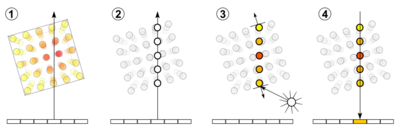
Volume ray casting
Encyclopedia
Volume ray casting, sometimes called volumetric ray casting, volumetric ray tracing, or volume ray marching, is an image-based volume rendering technique
. It computes 2D images from 3D volumetric data sets. Volume ray casting, which processes volume data, must not be mistaken with ray casting
, which processes surface data.
. It provides results of very high quality rendering. Volume ray casting is classified as an image-based volume rendering technique, as the computation emanates from the output image and not the input volume data, as is the case with object-based techniques.
 In its basic form, the volume ray casting algorithm comprises four steps:
In its basic form, the volume ray casting algorithm comprises four steps:
VR due to higher accuracy of volume ray-casting renderings.
The CT scan of crocodile mummy has resolution 3000×512×512 (16bit), the skull data-set has resolution 512×512×750 (16bit).
Volume rendering
In scientific visualization and computer graphics, volume rendering is a set of techniques used to display a 2D projection of a 3D discretely sampled data set.A typical 3D data set is a group of 2D slice images acquired by aCT, MRI, or MicroCT scanner....
. It computes 2D images from 3D volumetric data sets. Volume ray casting, which processes volume data, must not be mistaken with ray casting
Ray casting
Ray casting is the use of ray-surface intersection tests to solve a variety of problems in computer graphics. It enables spatial selections of objects in ascene by providing users a virtual beam as a visual cue extending...
, which processes surface data.
Classification
The technique of volume ray casting can be derived directly from the rendering equationRendering equation
In computer graphics, the rendering equation is an integral equation in which the equilibrium radiance leaving a point is given as the sum of emitted plus reflected radiance under a geometric optics approximation. It was simultaneously introduced into computer graphics by David Immel et al. and...
. It provides results of very high quality rendering. Volume ray casting is classified as an image-based volume rendering technique, as the computation emanates from the output image and not the input volume data, as is the case with object-based techniques.
Basic Algorithm

- Ray casting. For each pixel of the final image, a ray of sight is shot ("cast") through the volume. At this stage it is useful to consider the volume being touched and enclosed within a bounding primitive, a simple geometric object — usually a cuboidCuboidIn geometry, a cuboid is a solid figure bounded by six faces, forming a convex polyhedron. There are two competing definitions of a cuboid in mathematical literature...
— that is used to intersect the ray of sight and the volume. - Sampling. Along the part of the ray of sight that lies within the volume, equidistant sampling points or samples are selected. As in general the volume is not aligned with the ray of sight, sampling points usually will be located in between voxelVoxelA voxel is a volume element, representing a value on a regular grid in three dimensional space. This is analogous to a pixel, which represents 2D image data in a bitmap...
s. Because of that, it is necessary to trilinearly interpolateTrilinear interpolationTrilinear interpolation is a method of multivariate interpolation on a 3-dimensional regular grid. It approximates the value of an intermediate point within the local axial rectangular prism linearly, using data on the lattice points...
the values of the samples from its surrounding voxels. - Shading. For each sampling point, the gradientGradientIn vector calculus, the gradient of a scalar field is a vector field that points in the direction of the greatest rate of increase of the scalar field, and whose magnitude is the greatest rate of change....
is computed. These represent the orientation of local surfaces within the volume. The samples are then shaded, i. e. coloured and lighted, according to their surface orientation and the source of light in the scene. - Compositing. After all sampling points have been shaded, they are composited along the ray of sight, resulting in the final colour value for the pixel that is currently being processed. The composition is derived directly from the rendering equation and is similar to blending acetate sheets on an overhead projector. It works back-to-front, i. e. computation starts with the sample farthest from the viewer and ends with the one nearest to him. This work flow direction ensures that masked parts of the volume do not affect the resulting pixel.
Advanced Adaptive Algorithms
The adaptive sampling strategy allows dramatically reduce the rendering time for high quality rendering – the higher quality or/and bigger data-sets the more significant advantage over regular sampling strategy. However, adaptive ray-casting upon projection plane and adaptive sampling along each individual ray do not map well to the SIMD architecture of modern GPU; therefore, it is a common perception that this technique is very slow and not suitable for interactive rendering. Multi-core CPUs, however, are a perfect fit for this technique and may benefit marvelously from adaptive ray-casting strategy, making it suitable for interactive ultra-high quality volumetric rendering.Examples of high quality volumetric ray-casting
The gallery represents an output of high-quality volume ray casting. Commonly the crisp appearance of volume ray-casting images distinguishes them from output of texture mappingTexture mapping
Texture mapping is a method for adding detail, surface texture , or color to a computer-generated graphic or 3D model. Its application to 3D graphics was pioneered by Dr Edwin Catmull in his Ph.D. thesis of 1974.-Texture mapping:...
VR due to higher accuracy of volume ray-casting renderings.
The CT scan of crocodile mummy has resolution 3000×512×512 (16bit), the skull data-set has resolution 512×512×750 (16bit).

